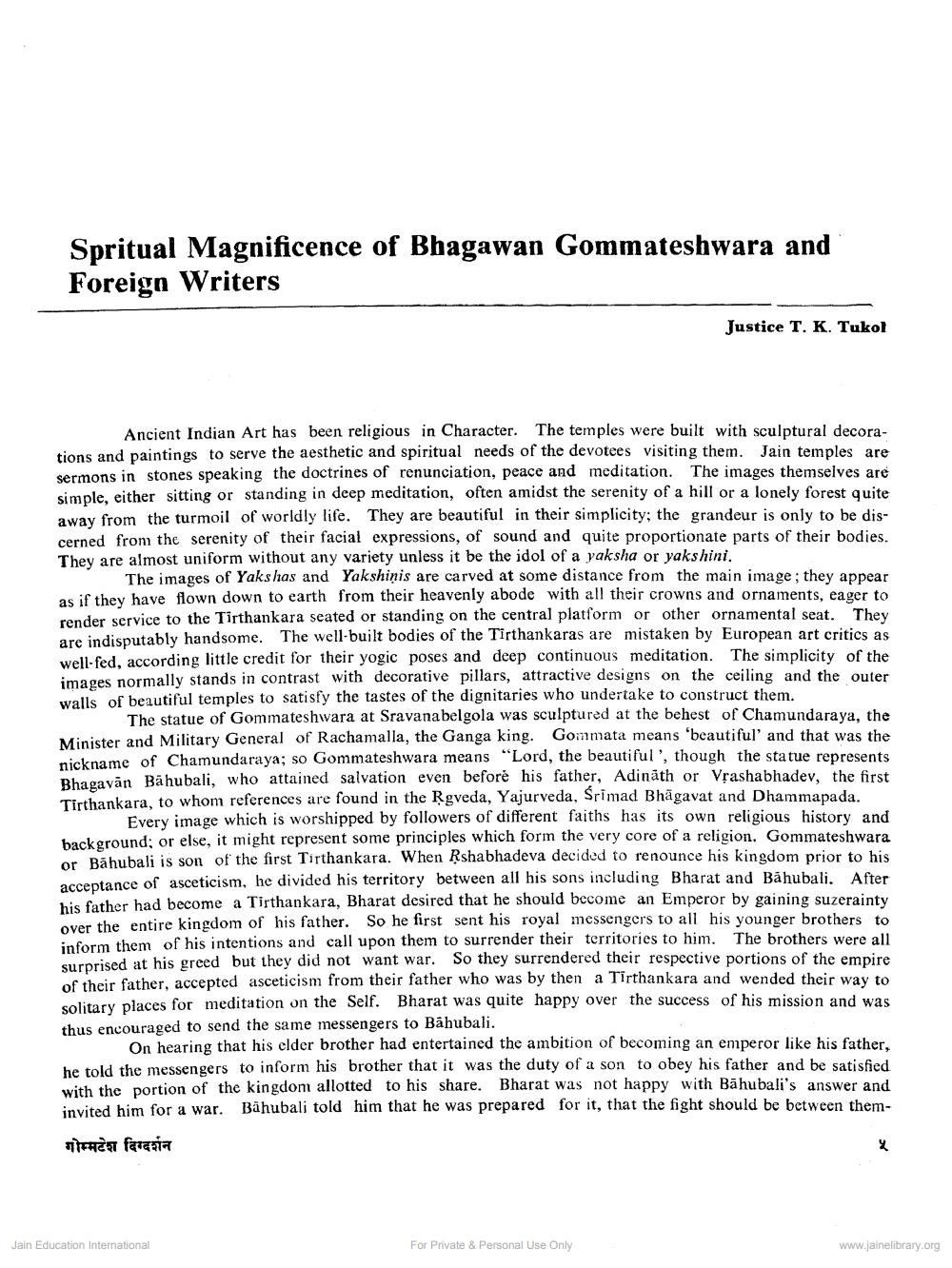________________
Spritual Magnificence of Bhagawan Gommateshwara and Foreign Writers
Justice T. K. Tukol
Ancient Indian Art has been religious in Character. The temples were built with sculptural decorations and paintings to serve the aesthetic and spiritual needs of the devotees visiting them. Jain temples are sermons in stones speaking the doctrines of renunciation, peace and meditation. The images themselves are simple, either sitting or standing in deep meditation, often amidst the serenity of a hill or a lonely forest quite away from the turmoil of worldly life. They are beautiful in their simplicity; the grandeur is only to be discerned from the serenity of their facial expressions, of sound and quite proportionate parts of their bodies. They are almost uniform without any variety unless it be the idol of a yaksha or yakshini.
The images of Yakshas and Yakshinis are carved at some distance from the main image; they appear as if they have flown down to earth from their heavenly abode with all their crowns and ornaments, eager to render service to the Tirthankara seated or standing on the central platform or other ornamental seat. They are indisputably handsome. The well-built bodies of the Tirthankaras are mistaken by European art critics as well-fed, according little credit for their yogic poses and deep continuous meditation. The simplicity of the images normally stands in contrast with decorative pillars, attractive designs on the ceiling and the outer walls of beautiful temples to satisfy the tastes of the dignitaries who undertake to construct them.
The statue of Gommateshwara at Sravanabelgola was sculptured at the behest of Chamundaraya, the Minister and Military General of Rachamalla, the Ganga king. Gommata means 'beautiful and that was the nickname of Chamundaraya; so Gommateshwara means "Lord, the beautiful', though the statue represents Bhagavān Bahubali, who attained salvation even before his father, Adinath or Vrashabhadev, the first Tirthankara, to whom references are found in the Rgveda, Yajurveda, Srimad Bhāgavat and Dhammapada.
Every image which is worshipped by followers of different faiths has its own religious history and background; or else, it might represent some principles which form the very core of a religion. Gommateshwara or Bahubali is son of the first Tirthankara. When Rshabhadeva decided to renounce his kingdom prior to his acceptance of asceticism, he divided his territory between all his sons including Bharat and Bahubali. After his father had become a Tirthankara, Bharat desired that he should become an Emperor by gaining suzerainty over the entire kingdom of his father. So he first sent his royal messengers to all his younger brothers to inform them of his intentions and call upon them to surrender their territories to him. The brothers were all surprised at his greed but they did not want war. So they surrendered their respective portions of the empire of their father, accepted asceticism from their father who was by then a Tirthankara and wended their way to solitary places for meditation on the Self. Bharat was quite happy over the success of his mission and was thus encouraged to send the same messengers to Bahubali.
On hearing that his elder brother had entertained the ambition of becoming an emperor like his father. he told the messengers to inform his brother that it was the duty of a son to obey his father and be satisfied with the portion of the kingdom allotted to his share. Bharat was not happy with Bahubali's answer and invited him for a war. Bahubali told him that he was prepared for it, that the fight should be between them
गोम्मटेश दिग्दर्शन
Jain Education International
For Private & Personal Use Only
www.jainelibrary.org




